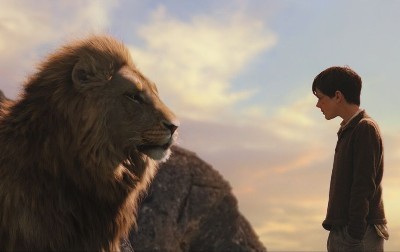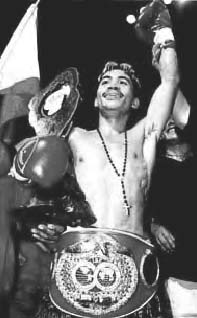 When Walt Disney announced in 2005 the release of the movie version of C.S. Lewis’s The Chronicles of Narnia (The Lion, the witch and the wardrobe), I saw the prospects for defeating the occult- and witchcraft- inspired Harry Potter series. The Chronicles, I believe, deserves greater attention and recognition. C.S. Lewis is considered by many as the one of the greatest Christian writers of the 20th century. His book, Mere Christianity, intelligently examines the validity and integrity of the Christian faith. Not surprisingly, Lewis's convictions can be found in the pages of the a seven-volume saga of the Chronicles of Narnia. They depict a world populated by dwarves and talking animals, giants and merpeople, centaurs and fauns. Narnia is ruled by a kind but awesomely ferocious and gigantic lion named Aslan. Lewis combined the three passions of his life—classical mythology, medieval knowledge, and Christian-based convictions. Movie-goers can easily appreciate the first two, but the third component can be easily overlooked because they are expressed in allusions and allegories. Belows are some of the scenes in the movie which apparently reflect Biblical truths.
When Walt Disney announced in 2005 the release of the movie version of C.S. Lewis’s The Chronicles of Narnia (The Lion, the witch and the wardrobe), I saw the prospects for defeating the occult- and witchcraft- inspired Harry Potter series. The Chronicles, I believe, deserves greater attention and recognition. C.S. Lewis is considered by many as the one of the greatest Christian writers of the 20th century. His book, Mere Christianity, intelligently examines the validity and integrity of the Christian faith. Not surprisingly, Lewis's convictions can be found in the pages of the a seven-volume saga of the Chronicles of Narnia. They depict a world populated by dwarves and talking animals, giants and merpeople, centaurs and fauns. Narnia is ruled by a kind but awesomely ferocious and gigantic lion named Aslan. Lewis combined the three passions of his life—classical mythology, medieval knowledge, and Christian-based convictions. Movie-goers can easily appreciate the first two, but the third component can be easily overlooked because they are expressed in allusions and allegories. Belows are some of the scenes in the movie which apparently reflect Biblical truths.THE USE OF CHILDREN - Many Lewis biographers claim that the Pevensie siblings represent the children who Lewis welcomed in his home. During the Second World War, he took in a number of children who had been evacuated from their homes due to air raids on London. The author's use of children not only aims to attract young readers, but also to magnify their innocence to sin—a character that Christ desires among His children. Matthew 19:13- 14: “When the children were brought to Jesus, He put His hands on them and pray. And the disciples rebuked them. But Jesus said, "Allow the little children to come to Me, and do not forbid them; for of such is the
FAITH IN CHRIST - In one scene, the professor helps Peter and Susan examine whether Lucy’s testimony about Narnia is valid. Lucy is representative of Christ who needs to convince her siblings (the people) regarding her claims. Lewis, in his book Mere Christianity presents a trilemma about Jesus: is He Lord, Liar, or Lunatic? Everyone has to make a choice.
WHITE WITCH AS satan– Obviously, the White Witch represents satan, who is the “Father of lies”, the “accuser” and the “adversary” (see John
EDMUND AND THE NATURE OF SIN – Many people can sympathize with the character of Edmund who struggles with temptation throughout his time in Narnia. Edmund succumbs to what John states as the three major sins: lust of the eyes, lust of the flesh and the pride of life (I John
CHRIST AND ASLAN – Lewis’s use of Aslan, the King Lion of Narnia is a symbol of Christ—the Lion of Judah: "See, the Lion of the tribe of Judah, the Root of David, has triumphed." (Rev 5:5).
CHRIST’s DEATH AND THE FORGIVENESS OF SINS – These truths are revealed when Aslan forgives Edmund after rescuing him from the White Witch. The lion tells the other siblings that “what is done is done” to avoid further strife. Paul states: "If someone is caught in a sin, you who are spiritual should restore him gently...Carry each other's burdens, and in this way you will fulfill the law of Christ." (Gal 6:1-2). When the White Witch meets Aslan for retribution, the lion king offers his own life in exchange for Edmund's. The act is symbolic of Christ dying for the sins of humanity: "While we were still sinners, Christ died for us." (Rom 5:8).
RESURRECTION AND “DEEP MAGIC”- Since the Chronicles are intended for a young audience, it would have been easier for Lewis to get across his message by using “fairy tales” and “magic stories” than presenting the hard facts about Biblical resurrection.
THE DIVISION OF TEMPLE CURTAIN AND CRYING WOMEN - The breaking of the Stone Table is similar to the curtain of the temple being torn (Luke 23:45). Moreover, the agony expressed by Lucy and her sister over Aslan’s death is symbolic of women who went to Jesus's omb: "Very early in the morning, the women took the spices they had prepared and went to the tomb. They found the stone rolled away from the tomb, but when they entered, they did not find the body of the Lord Jesus." (Luke 24:1-3).
 THE CHRISTIAN SPIRITUAL WARFARE - Another significant parallel is this: Aslan's calls his followers to battle against the White Witch. Like Christ, Aslan becomes the commander in chief of the protracted war. Christians constantly engage in a spiritual war (see Ephesians 6:10-18; 2 Corinthians 10:3-5; 1 Timothy 1:18-20; 1 Timothy 6:12; and 2 Timothy 4:7).
THE CHRISTIAN SPIRITUAL WARFARE - Another significant parallel is this: Aslan's calls his followers to battle against the White Witch. Like Christ, Aslan becomes the commander in chief of the protracted war. Christians constantly engage in a spiritual war (see Ephesians 6:10-18; 2 Corinthians 10:3-5; 1 Timothy 1:18-20; 1 Timothy 6:12; and 2 Timothy 4:7).
THE SECOND COMING OF CHRIST – The last scene showing the conversation between Tumnus and Lucy and with Aslan going far away from the castle depicts the ascension of Christ on Mt. Olives and his promised second advent. Tumnus comforts Lucy with the words, “We will see him again.” (see 1 Corinthians 15:51-5), 1 Thessalonians 4:13-17).






